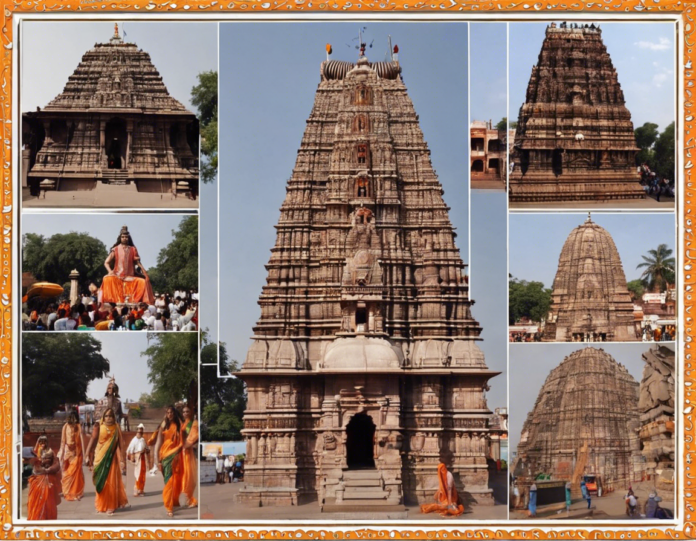The Mahakaleshwar Temple in Ujjain, India, is one of the most revered and ancient temples dedicated to Lord Shiva. The temple holds immense religious significance and is a prominent pilgrimage site for Hindus. With a rich history dating back centuries, the Mahakaleshwar Temple attracts devotees and tourists alike who come to seek blessings, witness the grandeur of its architecture, and immerse themselves in the spiritual aura that pervades the temple premises. In this article, we will delve into the history, architecture, significance, and rituals associated with the Mahakaleshwar Temple in Ujjain.
History of Mahakaleshwar Temple
The history of the Mahakaleshwar Temple can be traced back to ancient times, with references to the temple found in various texts and scriptures. It is believed that the temple was originally built by the Paramara dynasty rulers in the 6th century CE. Over the centuries, the temple has undergone multiple renovations and expansions, with contributions from various rulers and patrons.
One of the most fascinating aspects of the temple’s history is the legend associated with its origin. According to mythology, the Mahakaleshwar Temple is said to be the spot where Lord Shiva manifested himself as a Jyotirlinga, a symbolic representation of his infinite formless nature. The Jyotirlinga at Mahakaleshwar is believed to be Swayambhu, or self-manifested, and is considered one of the 12 Jyotirlingas in India.
Architecture of Mahakaleshwar Temple
The architecture of the Mahakaleshwar Temple is a blend of early medieval and Maratha styles, reflecting the contributions made by different rulers over the centuries. The temple complex is built in stone and features a towering shikhara (spire) that dominates the skyline of Ujjain. The entrance to the temple is adorned with intricate carvings and sculptures depicting various Hindu deities and mythological scenes.
Inside the temple, the sanctum sanctorum houses the Jyotirlinga of Mahakaleshwar, which is worshipped with great reverence by devotees. The inner chambers of the temple are adorned with ornate pillars, mandapas, and sculptures that showcase the artistic prowess of the craftsmen of yesteryears. The temple complex also includes smaller shrines dedicated to other deities, adding to the spiritual ambiance of the place.
Significance of Mahakaleshwar Temple
The Mahakaleshwar Temple holds immense religious significance for Hindus, especially devotees of Lord Shiva. Visiting the temple and offering prayers to the Jyotirlinga is believed to bestow blessings, fulfill wishes, and bring peace and prosperity to the devotees. The temple is also associated with various mythological legends and stories, adding to its mystical charm.
One of the unique aspects of the Mahakaleshwar Temple is the ritual of Bhasma Aarti, where the deity is adorned with ashes (bhasma) as an offering. The Bhasma Aarti is a daily ritual that takes place in the early hours of the morning and is a sight to behold for devotees and visitors. The atmosphere during the Aarti is charged with devotion and spirituality, creating a unique experience for everyone present.
Rituals and Festivals at Mahakaleshwar Temple
The Mahakaleshwar Temple is a hub of religious activities throughout the year, with various rituals and festivals being observed with great fervor. Mahashivaratri is one of the most important festivals celebrated at the temple, attracting a large number of devotees who come to seek the blessings of Lord Shiva.
Apart from Mahashivaratri, other festivals such as Navratri, Diwali, and Kartik Poornima are also celebrated with enthusiasm at the Mahakaleshwar Temple. Special pujas, abhishekas, and processions are organized during these festivals, adding to the festive spirit of the temple.
Visiting Mahakaleshwar Temple
For devotees and tourists planning to visit the Mahakaleshwar Temple, it is advisable to adhere to certain etiquette and guidelines to ensure a spiritually fulfilling experience. Wearing modest and respectful attire is recommended when visiting the temple, and maintaining silence and decorum inside the temple premises is essential.
Visitors should also be aware of the timings of the temple and plan their visit accordingly. It is advisable to check for any special events or festivals taking place at the temple during the time of your visit to make the most of the experience.
Frequently Asked Questions (FAQs)
Q1: What is the significance of the Jyotirlinga at Mahakaleshwar Temple?
A1: The Jyotirlinga at Mahakaleshwar Temple is believed to be a manifestation of Lord Shiva’s infinite and formless nature, and worshipping it is considered highly auspicious.
Q2: Is photography allowed inside the Mahakaleshwar Temple?
A2: Photography is generally not allowed inside the temple premises to maintain the sacred and peaceful atmosphere.
Q3: Are there any specific rituals that one must perform at the Mahakaleshwar Temple?
A3: Offering prayers, participating in the Bhasma Aarti, and sponsoring special pujas are some of the rituals that devotees can partake in at the temple.
Q4: What is the best time to visit the Mahakaleshwar Temple?
A4: The temple can be visited throughout the year, but Mahashivaratri and other festivals are ideal times to witness the grandeur and devotion at the temple.
Q5: Are there any accommodations available near the Mahakaleshwar Temple?
A5: Ujjain offers a range of accommodation options ranging from budget to luxury hotels near the temple premises for pilgrims and tourists.
In conclusion, the Mahakaleshwar Temple in Ujjain stands as a testament to the rich cultural heritage and spiritual legacy of India. With its ancient roots, magnificent architecture, and profound significance, the temple continues to draw devotees and visitors from far and wide, showcasing the enduring appeal of divine devotion and timeless traditions. A visit to the Mahakaleshwar Temple is not just a journey through history but a spiritual pilgrimage that leaves a lasting imprint on the soul.












